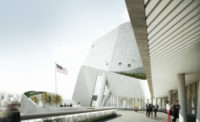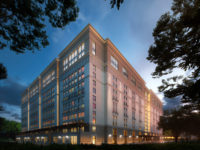There were more construction workers than shoppers in Miami’s Design District on Tuesday. A glass loggia by Sou Fujimoto was finished, as was a storefront by Aranda\Lasch for Tom Ford on a corner lot. But much else awaited completion. Craig Robins’s plan to turn the Design District into a high-end fashion destination, with architecture as a draw, is proceeding fitfully.
Following a master plan developed by Duany Plater Zyberk (DPZ), Robins has created a north-south pedestrian “street” that ends in what is now called Palm Court, a plaza centered on a replica Buckminster Fuller Fly's Eye Dome. Visitors who park below the plaza will arrive via a staircase under the dome. Alastair Gordon, in his first column as architecture critic of the Miami Herald, wrote that he likes to imagine it “nudging wealthy shoppers towards cosmic consciousness.” If only!
Occupying the west end of the plaza is Fujimoto’s two-story porch, made almost entirely of sheets of thick blue glass fastened together with obtrusive hardware. Behind it, half a dozen stores are under construction. The loggia is an inauspicious U.S. debut for the wildly inventive Fujimoto, who was almost certainly hobbled by the need for a facade behind which retailers could brand their respective storefronts. That meant his solution had to be interesting, but not interesting enough to compete with merchandise from the likes of Piaget and Lladro (only one of which is an anagram for dollar). One of the few storefronts that won’t be see-through is by architect Rene Gonzalez for the latest Alchemist jewelry boutique; it will be made of mirrored glass and “rose gold”-colored steel.
Up one of the escalators from the Palm Court is an event space with a cantilevered roof, a post-tensioned concrete slab bearing geometric patterns in relief (thanks to the ingenuity of Aranda\Lasch, the patterns were added at practically no cost by placing a reusable mold into regular formwork). Inside the space, Louis Vuitton is showing 18 pieces of furniture by Pierre Paulin, a French modernist designer who died in 2009. Paulin designed the pieces for Herman Miller in the 1970s—a display of Paulin’s original drawings and models fills one wall—but this is the first time they have been produced.
A new Tom Ford store down the block has yet to open, but its Aranda\Lasch exterior is one of the Design District’s big successes. Two perpendicular facades, made of GRFC, molded into a series of deep pleats, bring the southeast corner of the Design District to life. Meanwhile, Robins is planning additional buildings by a who’s-who of young architects, including Johnston Marklee, Leong Leong, NADAAA, MOS, and others. Robins pays the "design architects" modest fees, and then uses the global firm SB Architects as architect of record. Meanwhile, the Institute of Contemporary Art, Miami is planning to build a 37,500-square-foot building by the Madrid firm Aranguren & Gallegos, on land donated by Robins. David Cohn, Madrid-based correspondent for this magazine, calls the firm’s partners, both of whom were born in 1958, “very representative of the high creative level, serious and sober, of Madrid architects of their generation.”








